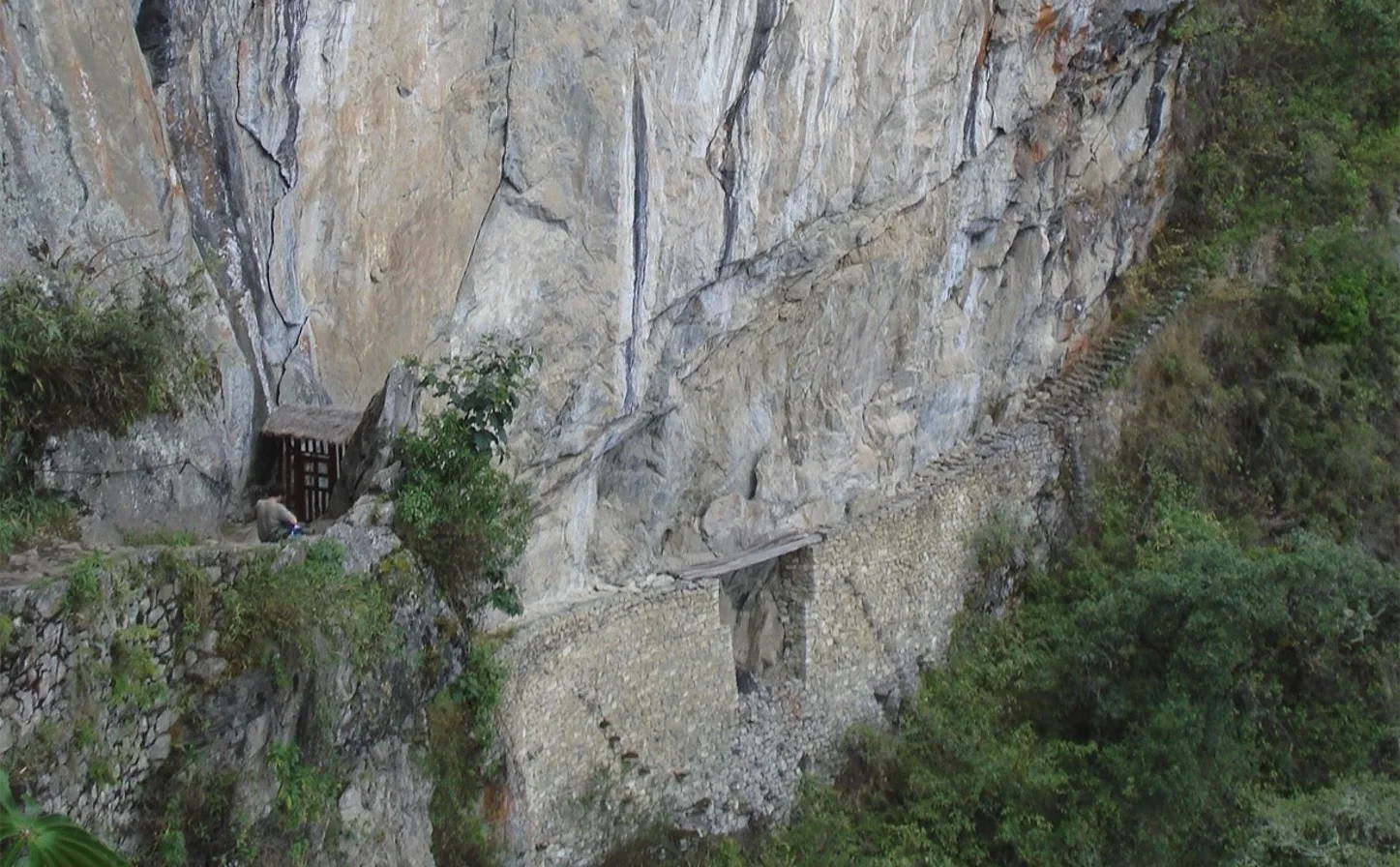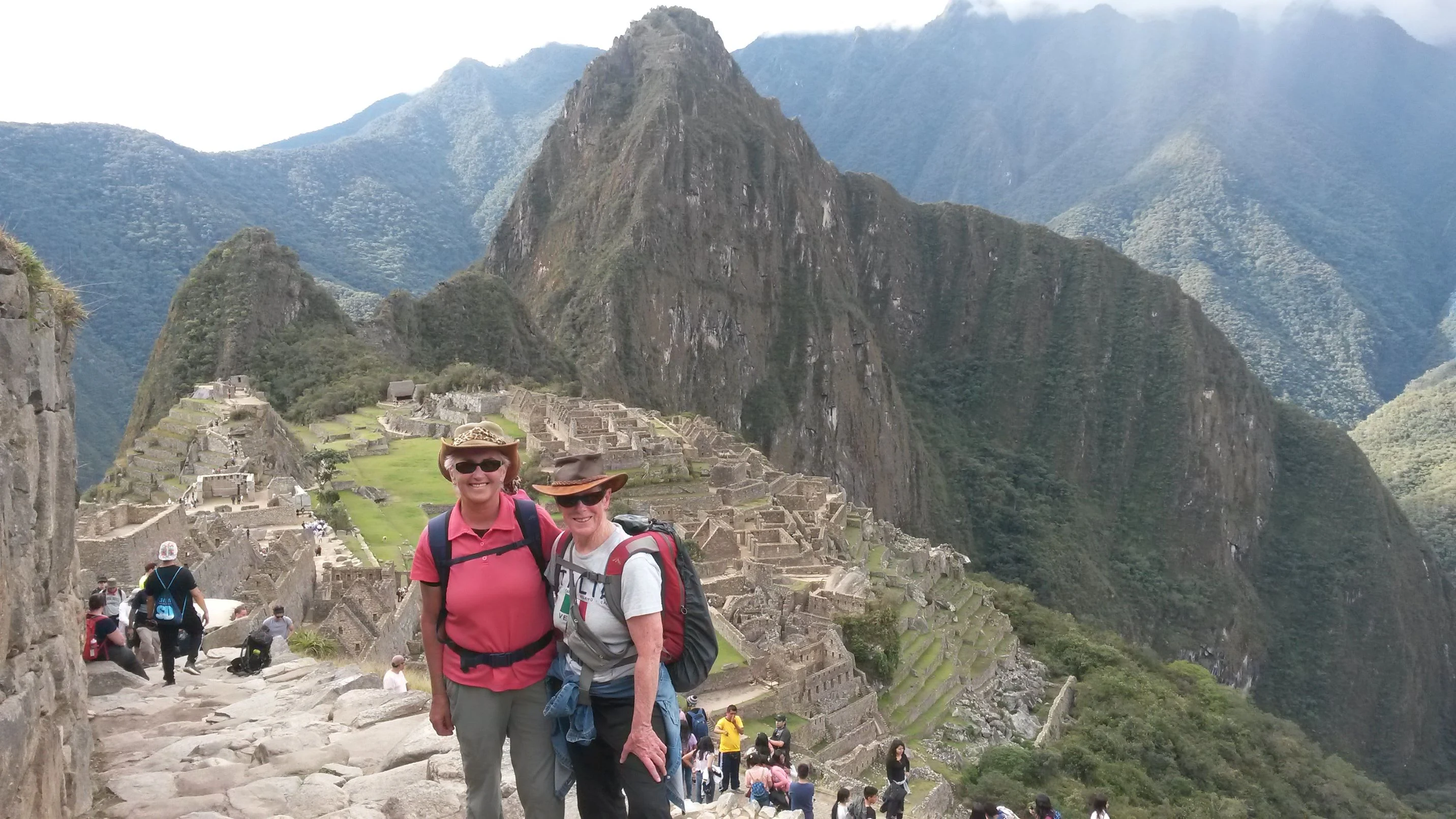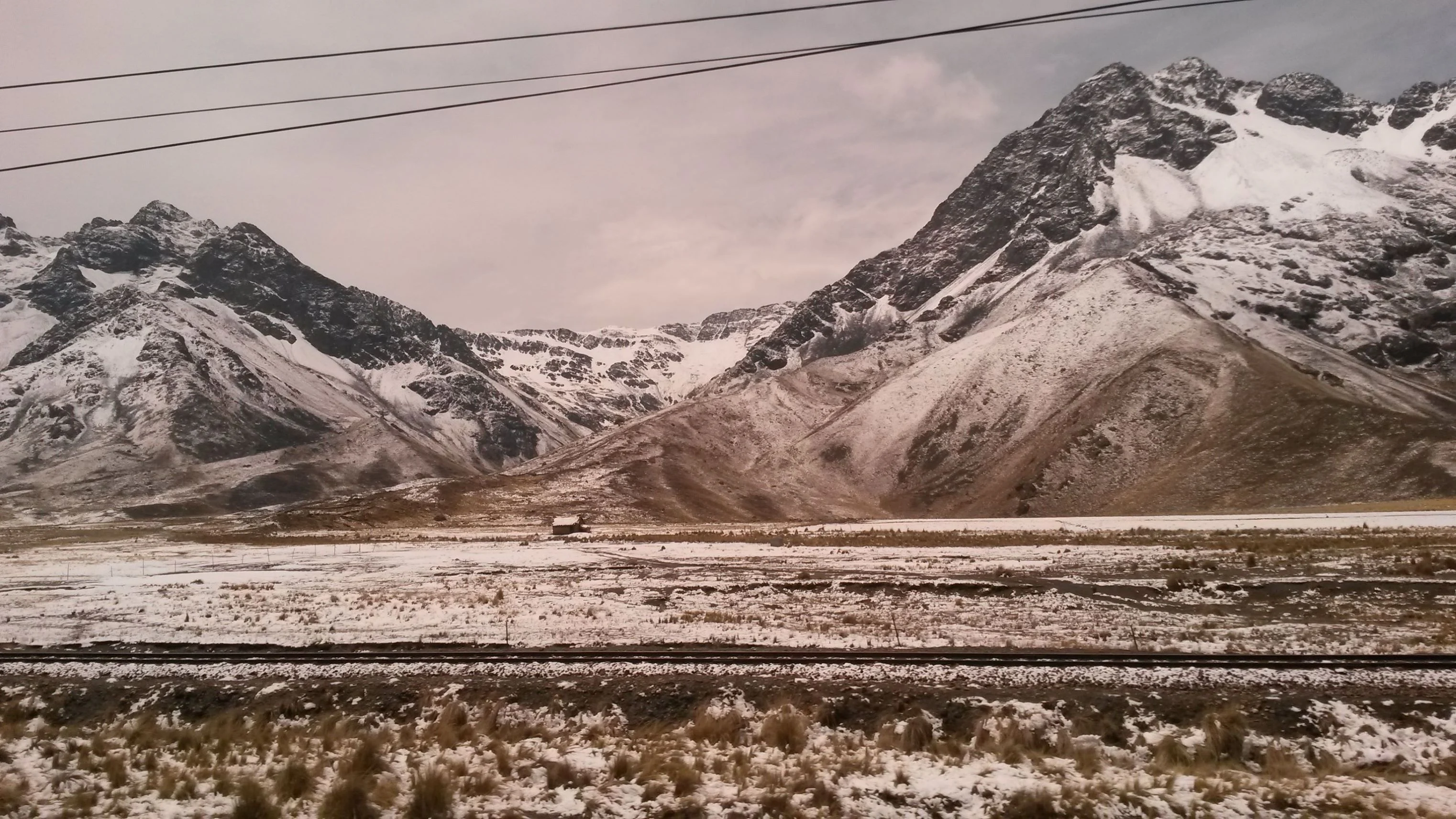We were now heading to the historic Peruvian city of Cusco, high in the Andes Mountains. From Cusco, we'll be able to access the ancient, and very high-altitude Inca Trail. We'll then hike the Trail, which will take us to the ruins of the Inca citadel of Machu Picchu, and we are really looking forward to it.
The Incas built their citadel on Machu Picchu Mountain, high in the Andes. Constructed in the 15th century, it is believed that it was built as a retreat for the Inca royals of the time. It was then abandoned 80 years later when the Spanish invaded Peru, but many of the structures remain. It is now a UNESCO World Heritage site that we wanted to visit.
But we needed to get to Cusco first. We'd just had several enjoyable days alongside Peru's Lake Titicaca in the city of Puno, so caught a Mer Line bus from there to Cusco.
The bus route took us through a mountainous and sparsely populated area of Peru that was incredibly scenic.
We had considered taking the train, which is supposed to be one of the more beautiful train rides in Peru. Then we learned that for about one-quarter of the price, we could take a bus along a road that ran alongside the railway line, and also provided great views, so that's what we did.
As well as driving past snow-peppered mountains, the bus took us through towns with tuk-tuks circling muddy red streets, market towns with colourful awnings, rural villages surrounded by agricultural terraces, and isolated farms. It was interesting, and the 7-hour trip passed surprisingly quickly.
Our bus arrived in Cusco pretty well on time, then we grabbed a taxi to our hotel in the centre of Cusco city.
Narrow, cobbled, and hilly streets greeted us in the centre, all the way to our accommodation - Hostal Amaru I, which is in an old stone building located on one of Cusco's very steep and narrow one-way streets.
The narrowness of the street, necessitated a quick exit from the taxi before there was too much horn blowing from behind! So we grabbed our suitcases, then dashed through beautiful wrought iron gates to discover that the Hostal was very quaint, and built in colonial style around a courtyard and gardens.
After a quick unpack, we headed out to explore Cusco.
Cusco is a UNESCO World Heritage city. These days, it's full of attractive Spanish Colonial structures, many built of stone with ornate wooden balconies hanging precariously over the street.
However, it was once the capital of the old Incan Empire, and the most important city for the Incas. The Inca presence is still felt here with many of the Spanish buildings being constructed on top of, or out of the original stones used by the Incas in their buildings.
Many of the most beautiful colonial buildings overlook the Plaza de Armas, the main square of Cusco.
One of the most decorative of the Plaza's buildings is the 1560's Cathedral which took almost a century to build. It is now full of amazing religious art and gold decorations. It's equally decorative neighbour, is the Baroque style Iglesia de la Companía de Jesús, which has the largest altar in Peru.
In the surrounding streets, we found many Inca handicraft shops, cafes, churches, museums, galleries, and houses, all beautifully maintained and presented.
The heavy vehicle and pedestrian traffic around the Plaza was controlled by female traffic police, each armed with a gun and a loud whistle, which they blew frequently. We'd seen similar in Puno, and they seemed to love blowing their whistles there too.
We found out that it wasn't just traffic they had their eyes on when Leigh stepped onto the manicured grass around the Plaza de Armas for a better angle on a photo. She was whistled at very loudly and waved to move off the grass - which she did - and very quickly!
Just up the hill from our hostel was the church of San Blas, set in San Blas Plaza - an attractive area with lots of handicraft shops and little cafes. We enjoyed lunch there several times, and it was cheaper than eating in the Plaza de Armas.
Cusco is very walkable and we walked many, many kilometres along its cobbled, quaint, narrow, and stepped streets.
We had a lovely time exploring this beautiful city before heading off on our Inca Trail hike to Machu Picchu.
We'd carefully researched how we might do the Machu Picchu part of our trip. We learned that the number of people allowed on the Inca Trail and Machu Picchu was limited, so we booked months in advance. Now the day of departure had finally arrived and we were very excited!
 |
| Driving into the ancient town of Ollantaytambo, Peru |
On the appointed day, we were picked up at 4:00 am by SAM Travel in Cusco, to begin our adventure. We were driven for about two hours through Peru's picturesque Sacred Valley of the Incas, to Ollantaytambo.
The rich soils in the Sacred Valley were utilised by at least three civilisations between 800 BCE and 1420 when the Incan Emperor Pachactui conquered the area, and built Ollantaytambo. The whole valley is now dotted with ancient ruins.
In Ollantaytambo, we caught the ‘Expedition train’ that goes to Machu Picchu. Its carriages had big panoramic windows in the ceiling and sides to enjoy the views throughout the journey.
The train route follows an original Inca trail over which the modern railway line was built. The line runs alongside the Urubamba River which flows through this very scenic mountainous area.
About 90 minutes later, and after watching anxiously for the signage, we got off at KM-104. This is not a built station, but a stop seemingly in the middle of nowhere. It involved climbing down from the train to trackside, which was quite a long stretch for short legs!
While waiting to meet our guide for our two-day trek on the Inca Trail, it started to rain. So, we donned our wet weather gear, standing in the middle of the train track with no shelter!
We were feeling a little blue about the weather, when our cheery guide, Edgard, appeared out of the rainy mist.
 |
| Beautiful scenery around the Urubamba River, Peru |
Soon after, we were heading across the Urubamba River, through a checkpoint to ensure only those with a valid pass could enter, and off we went.
Never mind the rain. We were off to experience something that has been on our bucket list for years, and now we were on our way. Woo hoo!
 |
| The Chachabamba ruins along the Inca Trail (UNESCO), Peru |
The trail took us past the Chachabamba archaeological site. This interesting Inca ruin sits along the trail at 2,171 metres above sea level in the subtropical forest of the Andes. It is thought to have been used as an important religious site, and a gate-house guarding the entrance to Machu Picchu.
As we left there, the morning mist started to clear, and we could see up the mountain toward the higher levels of the Inca Trail; so on we went.
The trail rose and fell around the mountainside. It was steep, rocky, difficult and interesting, and a real challenge in the high altitude and humid weather.
Then we arrived at some very large steps, and after a steady climb, reached Wiñaywayna, another archaeological site. Built in the 15th century, it is believed to have had religious and ceremonial importance, as well as being a rest stop for Incas on the trail to Machu Picchu.
 |
| Wiñaywayna viewed from across the valley, Inca Trail, Peru |
We initially spotted it across a valley, and it looked like a huge rock-slide in the greenery of the valley walls.
Once we arrived, we could see that the bulk of it was actually agricultural terraces left behind by the Incas. It also has upper and lower housing structures with big steps that connect the houses and also link to the amazingly steep terraces. It covers a large area of an almost vertical hillside and is in good condition.
 |
| Us at Wiñaywayna, Inca Trail, Peru |
What a wonderful place to have morning tea!
Edgard was a great guide giving us heaps of information and making it really interesting. He was also very good at setting a pace that worked for us, with plenty of breaks to get us up the steep parts in the heat and high altitude.
 |
| Beautiful views along the Inca Trail (UNESCO), Peru |
Leaving Wiñaywayna, we continued on the Trail, which has magnificent views down into the valley, and to the Urubamba River.
We stopped to eat lunch on the way and had plenty of snacks to keep our strength up.
Hours later, we came to an almost vertical flight of 50 uneven and huge steps. We took a look at this hurdle and thought we might not make it up there.
 |
| Us at the Sun Gate entrance to Machu Picchu (UNESCO), Peru |
But we pressed on, climbing slowly upwards, sometimes on hands and knees, then WOW!
At the top, we were rewarded with a spectacular view over the ancient Machu Picchu citadel ruins. It seems we had arrived at the original entrance of the citadel, called the Sun Gate or Intipunku.
We had made it over 12 km of rough hilly trail at high altitude, and were tired, but very proud of ourselves, and very happy.
The next bit was a very long walk down steep steps from the Gate, into the main part of these amazing ruins.
 |
| House ruins at Machu Picchu (UNESCO), Peru |
Finally, we arrived down into the streets of the ancient citadel of Machu Picchu. It was everything, if not more, than we'd anticipated.
We took lots of photos and explored as much as we could in the last hours of the day. Before long, it was time to head down to Aguas Calientes, at the base of Machu Picchu. We were spending the night there, so we could return to Machu Picchu the next day to explore some more.
 |
| The steep road down Machu Picchu Mountain, Peru |
Getting down the mountain was interesting! The route is along an unsealed road that zigzags its way down the mountain in a series of thirteen hairpin bends. You travel this road in one of the buses that make regular trips up and down the mountain, usually at a great speed while you hang on tightly.
It was quite an experience, and we would have to get back up and down the same way the next day!
 |
| Train through the main street of Aguas Calientes, Machu Picchu, Peru |
Arriving in Aguas Calientes, we found it to be full of hotels and handicraft stalls, and with a railway line running right through the centre of the main street. Quite novel, we thought.
After a good night’s sleep, we caught the bus back up the mountain early the next morning to continue to explore the Machu Picchu ruins.
Edgard met us up there, giving us a wonderful tour before leaving us to explore further on our own.
 |
| Us at Machu Picchu (UNESCO), Peru |
We picked up where we'd left off the day before, seeing some amazing ruins scattered across a plateau of the mountain top, and others defying gravity as they cascaded down its steep sides.
Sauntering around, we saw the main plaza with several llamas grazing, amazing monuments such as the Sacred Stones in the Temple of the Condor, and the ritual stone called Intihauatana, plus intriguingly worn ancient stone stairways to stone houses.
 |
| Some of the ancient structures on Machu Picchu (UNESCO), Peru |
We wandered through places such as the Sun Temple, Ñusta's Palace, the Royal Tomb and Palace, and the Royal Temple. We visited the Temple of the Sun and the Room of the Three Windows, and struggled up the amazing cultivation terraces. There was so much to see!
Buildings here are constructed out of large stones cut to support each other, with no mortar or other method of keeping the stones in place, and the layout mirrors the peaks and plateaus of the surrounding mountains. It is a wonderful feat of engineering.
 |
| Inca Bridge, Machu Picchu (UNESCO), Peru |
Our last stop was at the Inca Bridge, a very narrow stone path cleverly built into a vertical cliff-face. It has its name from a 6-metre gap that is bridged by two sturdy logs. The logs, when removed, are an effective defence system against outsiders using the path.
After a stunning day, we bussed down the mountain again to catch our train back to Ollantaytambo, then caught a mini-van back to Cusco. Eventually, two very tired travellers made it back to Cusco and the hostel.
After an initial issue with our booking at the hostel, we unpacked, looking forward to seeing more of Cusco.
 |
| San Pedro market, Cusco (UNESCO), Peru |
Over the next few days, we visited museums, the local market, and art galleries, and tried on the locally produced llama and alpaca wool products (almost as many here as in Bolivia); but resisted buying (no room in the suitcase).
While out walking, we spotted a hairdressing salon and Marg braved a haircut by a local.
Leigh normally does the family haircuts, but there had been no opportunity for a cut for over 6 weeks and we were both looking a bit feral. The hairdresser did a great job - all for the price of about NZ$12. A bargain!
 |
| Courtyard where we had lunch, Cusco (UNESCO), Peru |
After lunch in a lovely little courtyard, we headed to the Post office as we wanted to post a birthday present to our grandson Callum. Suddenly, there were our friends Bruno and Lorna who we had met in Bolivia. It was so lovely to see them again and we had a nice catch up.
The following morning, we headed to the bus station and the next part of our trip which is to Chivay in Peru's Colca Canyon.
This is part of a blog series about our travels through the north-eastern countries of South America. The first blog in this series is called “In and around Santiago”.











